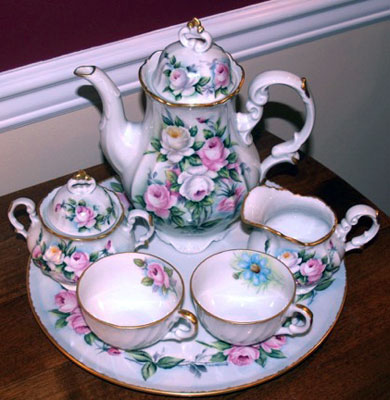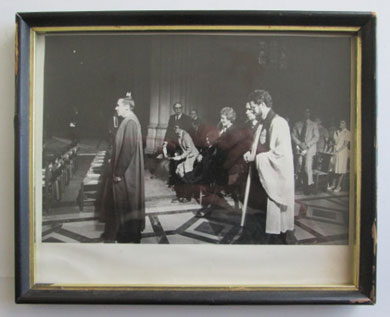 |
|
|||
 |
 |
|||
RINKER ON COLLECTIBLES — Column #1467 Copyright © Harry Rinker, LLC 2014 Questions
and Answers
QUESTION: My grandmother Christine L. Beagle, who lived in the Prospect Park area of Philadelphia, was a talented porcelain painter. Forms included dishes, lamps, and tea sets. She gave away most the pieces she painted as gifts or donations to charity or church luncheons. She usually signed her pieces “C. L. Beagle.” Over the years, I have searched online in hopes of finding some of these pieces. I have had no success. Is there a site or place of which you are aware that can help me find examples of my grandmother’s hand painted china? – KD, State College, PA Email Question
ANSWER: Luck is the primary ingredient in finding the proverbial needle in the antiques and collectibles haystack. The keys are (1) to spread the word that you are looking and (2) be patient and persistent. I have three “Rinker” pieces in my possession thanks to an individual who contacted me when he wanted to sell, a friend who found a piece containing the signature of Henry (Heinrick) Rinker, one of my immigrant ancestors, and a lucky find during a visit to an antique shop in the Lehigh Valley area. The picture of the tea set that accompanied your email shows your grandmother loved to paint flowers, especially roses, the next lessons after “how to paint bunches of grapes” in porcelain painting illustrated texts of the late nineteenth and early twentieth century. My suspicion is that once she found her floral niche, she did not progress further. The fact that your grandmother signed her pieces is a plus. Collectors of hand painted porcelain prefer signed pieces. There may be some in private collections. Make up a brochure providing a brief history of your grandmother’s china painting, a few illustrations, and your contact information and circulate to flea market and show dealers within a 50-mile radius of Philadelphia. Since your grandmother donated or gifted most of her pieces, chances are they remained with families located in the Prospect Park area. Consider placing a business card sized advertisement in one or more of the antiques and collectibles trade newspapers, such as the Eastern Edition of “AntiqueWeek,” that serve the Middle Atlantic States. Create a website focusing on your grandmother’s painted china and invite viewers to contact you if they have pieces in their collection or for sale. Obtain copies of Dorothy Kamm’s “American Painted Porcelain Collectors Identification Guide” (Collector Books, 1997) and “Antique Trader’s Comprehensive Guide to American Painted Porcelain, 2nd Edition” (Krause Books, 1999). If you are lucky, you may find one of your grandmother’s pieces illustrated. Do an internet search for Dorothy Kamm. The last known address I have for her in my files is a post office box in Port Saint Lucie, Florida. There is no hand painted porcelain collectors’ club. Individuals still hand paint porcelain blanks as a hobby. There is an organization for these hobbyists. This is definitely a long-term project. Good luck. QUESTION: I have lithograph tin baseball bank. The sweet spot is marked “PHILADELPHIA ATHLETICS” above a printed signature of Connie Mack. Beneath this is a circle containing “SAVE / WITH / ATLANTIC.” The top of the ball reads: “COMPLEMENTS OF / YOUR / ATLANTIC DEALER.” The back of the bank is illustrated with an Elephant wearing a cloth with “As.” The bank has a red collar base. I paid $75.00 for it. How much is it worth? – L, Fleetwood, PA ANSWER: The first step is to date your bank. Connie Mack coached the Philadelphia Athletics from the club’s founding in 1901 until the end of the 1951 season. Hence, the bank has to date from 1951 or earlier. Atlantic Petroleum, a descendent of the Standard Oil Trust, was headquartered in Philadelphia. Atlantic Petroleum merged with Richfield Oil in 1966 and became ARCO. “Broadcasting” March 30, 1942 (Vol. 22. No. 13) contains an article entitled “Atlantic Books Largest Baseball Series.” Atlantic co-sponsored home games of the Philadelphia Athletics and Philadelphia Phillies. It also was a sponsor of the Pittsburgh Pirates and teams from the International, Eastern, South Atlantic, and Piedmont Leagues. [Author’s Aside: As a Cub Scout in the late 1940s, I attended a Philadelphia Athletics game held at Shibe Park, later Connie Mack Stadium. My most memorable moment of the game was having my wallet picked which resulted in my being unable to buy refreshments. For a lad from a small town, it sent the wrong message about life in the big city.] I date your bank from the late 1940s or early 1950s. It is safe to rule out the period from 1942 to 1945 when tin was devoted to wartime production. It does not appear pre-war to me. I found an example for sale on eBay for $84.99 plus $5.00 shipping. Thus far, no buyers have stepped forward. The $75.00 you paid is or is close to top market dollar. At the moment, the primary buyers are Philadelphia Athletic collectors. My suspicion is those collectors who want one already have an example in their collection. The next group is the lithograph tin, advertising bank collectors. This group will not pay a premium “baseball” price. The bank is worth between $45.00 and $50.00 to a figural advertising bank collector. At this point, enjoy the bank. If it was not worth the $75.00 you paid for it to you, you should not have bought it. You did not pay too much nor did you get a bargain. Instead, you purchased a memory that has special meaning to you. Smile every time you look at the bank. TRIVA QUIZ: What year did the Philadelphia Athletics move to Kansas City? QUESTION: I have two framed prints, each pictures a wolf standing on a snow covered mountain looking down on a farmstead. One is black and white and the other is colored. Each frame is approximately 16 x 14 inches. The prints appear identical. What can you tell me about these prints and their value? – J, Bozman, MT ANSWER: The “Lone Wolf” print was one of the most popular prints of the first half of the 20th century. Modern reproductions are readily available. Alfred Jan Maksymillian Kowalski (October 11, 1849 to February 16, 1915), a Polish painter associated with the Munich School, painted the period image. Kowalski studied in Dresden and Warsaw. He settled in Munich in 1873, spending a year attending the Munich Academy of Fine Arts. He became an honorary professor at the Academy in 1890. The location of Kowalski’s “Lone Wolf” painting is unknown. In the 1920s, academic trained artists knocked out oil copies of the Kowalski painting for sale in the American and German markets. In addition, numerous prints appeared. While a common practice is to attribute some of the 1920s paintings to Kowalski, this is impossible since he died in 1915. The fun thing about the reproduction paintings and prints is that the location of the wolf alternates between the right and left. Clearly, a photograph negative was reversed and printed as such, hence, the two different scenes. The period painting had the wolf on the right. Kowalski did a painting of a similar wolf on the left, but this wolf is overlooking a flowing stream with ice pieces in it. “Lone Wolf” prints can be found in a variety of sizes. Your print is among the most common sizes. Assuming it is in very good condition, matted with acid free mat, and no acidic backing, it has a secondary market value between $40.00 and $60.00. In the last decades of the 20th century, the print sold for more. However, interest has waned over the years. Modern reproduction prints are readily available between $7.50 and $20.00. QUESTION: I have a Morton Broffman black and white photograph of President Nixon taken two days before he left office. A South Bay Drug label on the back of the frame notes: “The Rev. Jeffrey P. Cave with President Nixon and Pat at the Washington Cathedral DC two days before he left office.” The back of the picture is stamped: “ PHOTOGRAPHED BY / MORTON BROFFMAN / 205 North Madison Avenue, Arlington, VA….” I have found more than 1,500 photographs of Nixon on eBay, with most selling for under $10.00 and with free shipping. I did not find any Broffman Nixon photographs. What is the value of my Nixon photograph? – SK, Richmond, CA, Email Question
ANSWER: Morton Broffman, a Washington, DC. photographer, died of ALS in 1992. According to http://mortonbroffman.com/, Broffman “was also the principal photographer for The Cathedral Age magazine, published by the Washington National Cathedral. The Broffman archive contains tens of thousands of photos taken during the most exciting phase of the National Cathedral's history: the final 30 years of its construction. It is the most comprehensive source for National Cathedral imagery available.” The Broffman Nixon photograph was sold commercially. I discovered you listed your framed Broffman Nixon photograph on www.doublequicktime.com for sale at $24.99. Thus far, no one has come forward to buy it. [www.doublequicktime.com/item/description/id/63880403]. Your price is not realistic. I suggest $10.00 or less plus shipping. TRIVA QUIZ ANSWER: 1954Harry L. Rinker welcomes questions from readers about
collectibles, those mass-produced items from the twentieth and twenty-first centuries.
Selected letters will be answered in this column.
Harry cannot provide personal answers.
Photos and other material submitted cannot be
returned.
Send your questions to: Rinker on Collectibles, 5955 Mill
Point Court SE, Kentwood, MI 49512.
You also can e-mail your questions to
harrylrinker@aol.com.
Only e-mails containing a full name and mailing address
will be considered.
You can listen
and participate in
WHATCHA GOT?, Harry’s
antiques and collectibles radio call-in show, on Sunday mornings between 8:00 AM
and 10:00 AM Eastern Time.
If you
cannot find it on a station in your area,
WHATCHA GOT?
streams live on the Internet at www.gcnlive.com.
SELL, KEEP OR TOSS?: HOW TO DOWNSIZE A HOME,
SETTLE AN ESTATE, AND APPRAISE PERSONAL PROPERTY
(House of Collectibles, an imprint of Random House Information Group, $17.99),
Harry’s latest book, is available at your favorite bookstore and via
www.harryrinker.com.
|
||||

